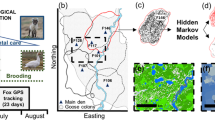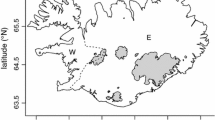Abstract
Prey response to novel predators influences the impacts on prey populations of introduced predators, bio-control efforts, and predator range expansion. Predicting the impacts of novel predators on native prey requires an understanding of both predator avoidance strategies and their potential to reduce predation risk. We examine the response of island foxes (Urocyon littoralis) to invasion by golden eagles (Aquila chrysaetos). Foxes reduced daytime activity and increased night time activity relative to eagle-naïve foxes. Individual foxes reverted toward diurnal tendencies following eagle removal efforts. We quantified the potential population impact of reduced diurnality by modeling island fox population dynamics. Our model predicted an annual population decline similar to what was observed following golden eagle invasion and predicted that the observed 11% reduction in daytime activity would not reduce predation risk sufficiently to reduce extinction risk. The limited effect of this behaviorally plastic predator avoidance strategy highlights the importance of linking behavioral change to population dynamics for predicting the impact of novel predators on resident prey populations.



Similar content being viewed by others
References
Bakker VJ, Garcelon DK, Aschehoug ET, Crooks KR, Newman C, Schmidt GA, Van Vuren DH, Woodroffe R (2005) Current status of the Santa Cruz Island fox (Urocyon littoralis santacruzae). In: Garcelon DK, Schwemm CA (eds) Proceedings of the sixth California Islands symposium. Institute for Wildlife Studies, Arcata, pp 275–298
Banks PB, Dickman CR (2007) Alien predation and the effects of multiple levels of prey naiveté. Trends Ecol Evol 22:229–230
Benard MF (2006) Survival trade-offs between two predator-induced phenotypes in Pacific treefrogs (Pseudacris regilla). Ecology 87:340–346
Berger J, Swenson JE, Persson I-L (2001) Recolonizing carnivores and naive prey: conservation lessons from Pleistocene extinctions. Science 291:1036–1039
Clavero M, Garcia-Berthou E (2005) Invasive species are a leading cause of animal extinctions. Trends Ecol Evol 20:110–110
Cohen B, Cory C, Menke J, Hepburn A (2009) A spatial database of Santa Cruz Island vegetation. In: Damiani CC, Garcelon DK (eds) Proceedings of the seventh California Islands symposium. Institute for Wildlife Studies, Arcata, CA, pp 229–244
Collins PW, Latta BC (2009) Food habits of nesting Golden Eagles (Aquila chrysaetos) on Santa Cruz and Santa Rosa islands, California. In: Damiani CC, Garcelon DK (eds) Proceedings of the Seventh California Islands Symposium. Institute for Wildlife Studies, Arcata, pp 255–268
Collins PW, Guthrie DA, Rick TC, Erlandson JM (2005) Analysis of prey remains excavated from an historic bald eagle nest site on San Miguel Island, California. In: Garcelon DK, Schwemm CA (eds) Proceedings of the sixth California Islands symposium. Institute for Wildlife Studies, Arcata, CA, pp 103–120
Collopy MW (1984) Parental care and feeding ecology of golden eagle nestlings. Auk 101:753–760
Coonan TJ, Schwemm CA (2009) Factors contributing to success of island fox reintroductions on San Miguel and Santa Rosa Islands, California. In: Damiani CC, Garcelon DK (eds) Proceedings of the 7th California Islands symposium. Institute for Wildlife Studies, Arcata, pp 363–376
Coonan TJ, Rutz K, Garcelon DK, Latta BC, Gray MM, Aschehoug ET (2005) Progress in island fox recovery efforts on the north Channel Islands. In: Garcelon DK, Schwemm CA (eds) Proceedings of the sixth California Islands symposium. Institute for Wildlife Studies, Arcata, pp 263–274
Cox JG, Lima SL (2006) Naiveté and an aquatic-terrestrial dichotomy in the effects of introduced predators. Trends Ecol Evol 21:674–680
Crooks KR (1994) Comparative ecology of the island spotted skunk and the island fox of Santa Cruz Island, California. M.S. Thesis. University of California, Davis
Crooks KR, Van Vuren D (1995) Resource utilization by two insular endemic mammalian carnivores, the island fox and island spotted skunk. Oecologia 104:301–307
Farias V, Todd KF, Wayne RK, Sauvajot RM (2005) Survival and cause-specific mortality of gray foxes, Urocyon cinereoargenteus, in southern California. J Zool 2006:249–254
Fenn MGP, MacDonald DW (1995) Use of middens by red foxes: risk reverses rhythms of rats. J Mammal 76:130–136
Fraser DE, Gilliam JF, Akkara JT, Albanese BW, Snider SB (2004) Night feeding by guppies under predator release: effects on growth and daytime courtship. Ecology 85:312–319
Geffen E, MacDonald DW (1993) Activity and movement patterns of Blanford’s foxes. J Mammal 74:455–463
Gompper ME (2002) Top carnivores in the suburbs? Ecological and conservation issues raised by colonization of north eastern North America by coyotes. Bioscience 52:185–190
Holomuzki JR (1986) Predator avoidance and diel patterns of microhabitat use by larval tiger salamanders. Ecology 67:737–748
Kauhala K (1996) Introduced carnivores in Europe with special reference to central and northern Europe. Wildlife Biology 2:197–204
Kavanau JL, Ramos J (1975) Influences of light on activity and phasing of carnivores. American Naturalist 109:391–418
Kiff LF (1980) Historical changes in resident populations of California Islands raptors. In: Power DM (ed) The California Islands: proceedings of a multidisciplinary symposium. Santa Barbara Museum of Natural History, Santa Barbara, pp 651–673
Lima SL, Bednekoff PA (1999) Temporal variation in danger drives antipredator behavior: the predation risk allocation hypothesis. American Naturalist 153:649–659
Metcalfe NB, Steele GI (2001) Changing nutritional status causes a shift in the balance of nocturnal to diurnal activity in European minnows. Funct Ecol 15:304–309
Metcalfe NB, Fraser NHC, Burns MD (1998) State-dependent shifts between nocturnal and diurnal activity in salmon. Proceedings of the Royal Society B: biological sciences 265:1503–1507
Roemer GW (1999) The ecology and conservation of the island fox (Urocyon littoralis). Ph.D. Dissertation. University of California, Los Angeles
Roemer GW, Garcelon DK, Coonan TJ, Schwemm C (1994) The use of capture recapture methods for estimating, monitoring, and conserving island fox populations. In: Halvorson WL, Garcelon DK (eds) The fourth California Islands symposium: update on the satus of resources. Santa Barbara Museum of Natural History, Santa Barbara, pp 387–400
Roemer GW, Donlan CJ, Courchamp F (2002) Golden eagles, feral pigs, and insular carnivores: how exotic species turn native predators into prey. Proc Natl Acad Sci USA 99:791–796
Rohr JR, Madison DM, Sullivan AM (2003) On temporal variation and conflicting selection pressures: a test of theory using newts. Ecology 84:1816–1826
Salo P, Korprimaki E, Banks PB, Nordstrom M, Dickman CR (2007) Alien predators are more dangerous than native predators to prey populations. Proceedings of the Royal Society B 274:1237
Salo P, Nordstrom M, Thomson RL, Korpimaki E (2008) Risk induced by a native top predator reduces alien mink movement. J Anim Ecol 77:1092–1098
Simberloff D, Stiling P (1996) Risks of species introduced for biological control. Biol Conserv 78:185–192
Sokal R, Rohlf F (1995) Biometry, 3rd edn. W.H. Freeman and Company, New York
Swarts HM, Crooks KR, Willits N, Woodroffe R (2009) Possible contemporary evolution in an endangered species, the Santa Cruz Island fox. Anim Conserv 12:120–127
Timm SF, Muson L, Summers BA, Terio KA, Dubovi EJ, Rupprecht CE, Kapil S, Garcelon DK (2009) A suspected canine distemper epidempic as the cause of a catastrophic decline in Santa Catalina Island foxes (Urocyon littoralis catalinae). J Wildl Dis 45:333–343
United States Fish Wildlife Service (2004) Endangered and threatened wildlife and plans; listing the San Miguel Island Fox, Santa Rosa Island Fox, Santa Cruz Island Fox, and Santa Catalina Island Fox as endangered. Fed Regist 69:10335–10353
Wayne RK, George SB, Gilbert D, Collins PW (1991) A morphologic and genetic study of the island fox, Urocyon littoralis. Evolution 45:1849–1868
Werner EE, Gilliam JF, Hall DJ, Mittelbach GG (1983) An experimental test of the effects of predation risk on habitat use in fish. Ecology 64:1540–1548
Acknowledgments
We thank R. Wolstenholme, J. Fox, A. Blackford, J. Chelko, C. Newman, Z. Smith, K. Kapheim, G. Cline, R. Rumelhart, S. Krause, and G. Schmidt for their efforts in collecting and managing activity data. D. Van Vuren, The Nature Conservancy, National Park Service, and US Navy provided logistical support. The manuscript was improved by comments from K. Crooks, T. Coonan, B. Cypher, M. Potter, and J. Young. Data collection was funded by The Nature Conservancy. This study complied with the current laws of the United States of America and state of California.
Author information
Authors and Affiliations
Corresponding author
Additional information
Communicated by Peter Banks.
Rights and permissions
About this article
Cite this article
Hudgens, B.R., Garcelon, D.K. Induced changes in island fox (Urocyon littoralis) activity do not mitigate the extinction threat posed by a novel predator. Oecologia 165, 699–705 (2011). https://doi.org/10.1007/s00442-010-1761-7
Received:
Accepted:
Published:
Issue Date:
DOI: https://doi.org/10.1007/s00442-010-1761-7




